Abstract
Fifty four infants with hepatobiliary disease and conjugated hyperbilirubinaemia of more than two weeks' duration were identified in a defined area of south east England in a prospective study between January 1971 and December 1973. The overall incidence was one case per 2500 live births. The cases were regularly reviewed and all survivors except one were assessed at age 10 years. Nine of 11 with extrahepatic biliary atresia died from liver disease by 2 years of age, one died at 5 years, and the survivor has cirrhosis with portal hypertension. Four out of seven with alpha 1 antitrypsin deficiency died aged 1 to 3 years from liver disease and one of the survivors has cirrhosis. All three infants with intrauterine infection and one with chromosomal abnormality died in infancy. Three children with other associated factors, choledochal cyst, galactosaemia, and rhesus isoimmunisation, recovered completely with no persisting liver disease. Two of 29 with cryptogenic hepatitis died, but only a further two have signs of persisting liver disease. Perinatal complications were more common in this group. Four of the 27 children surviving to the age of 10 years are educationally subnormal. Prognosis for infants with intrahepatic liver disease in the absence of known associated factors is good and every effort should be made to minimise the short term effects of cholestasis.
Full text
PDF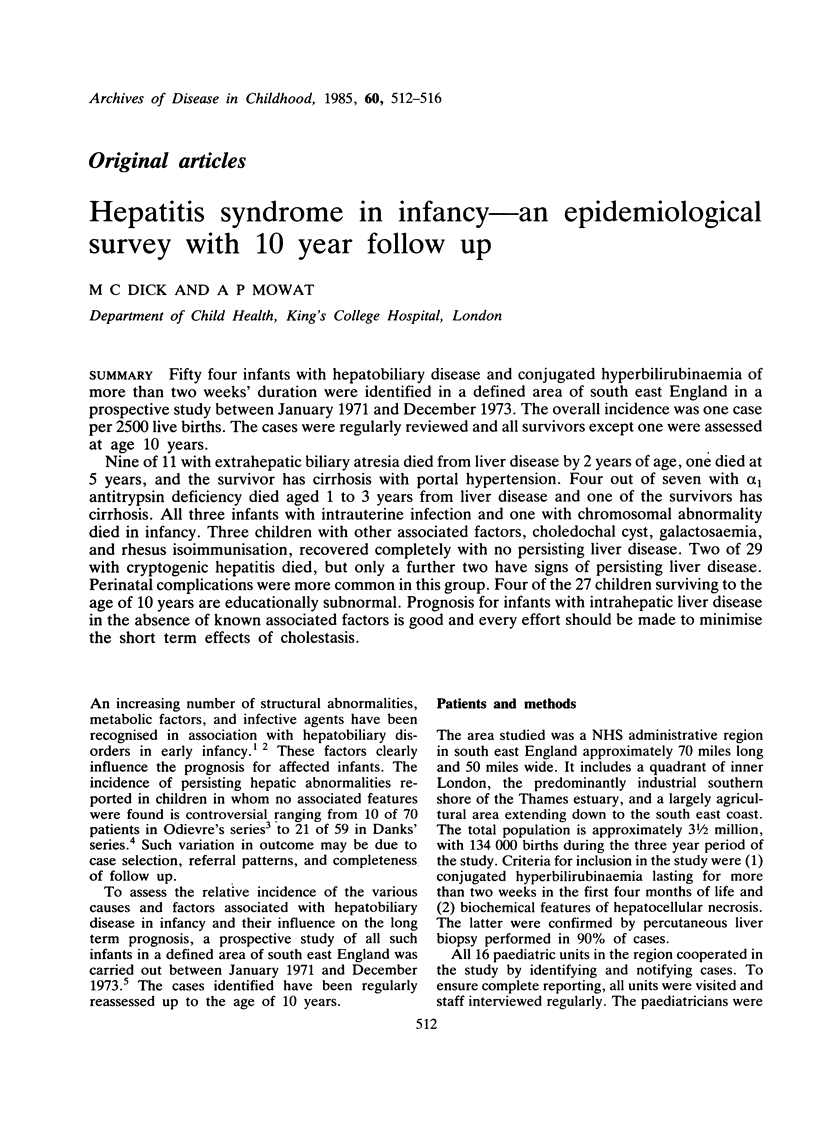
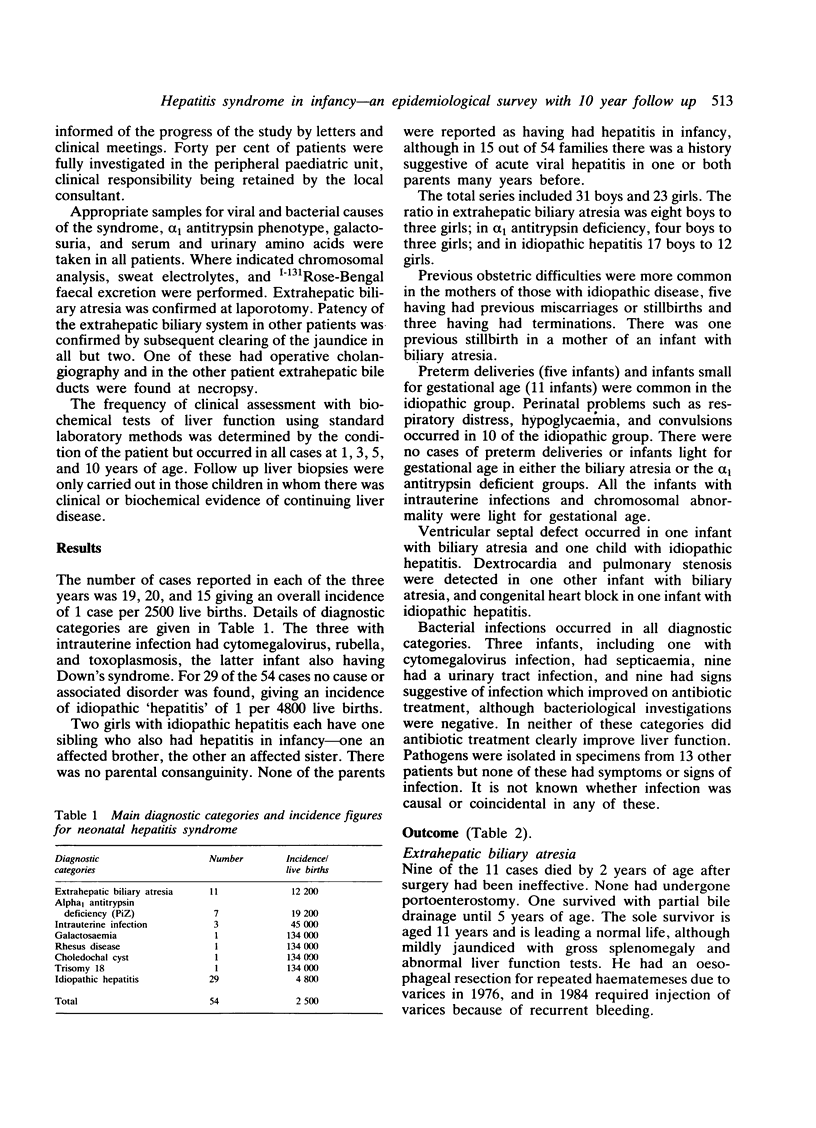
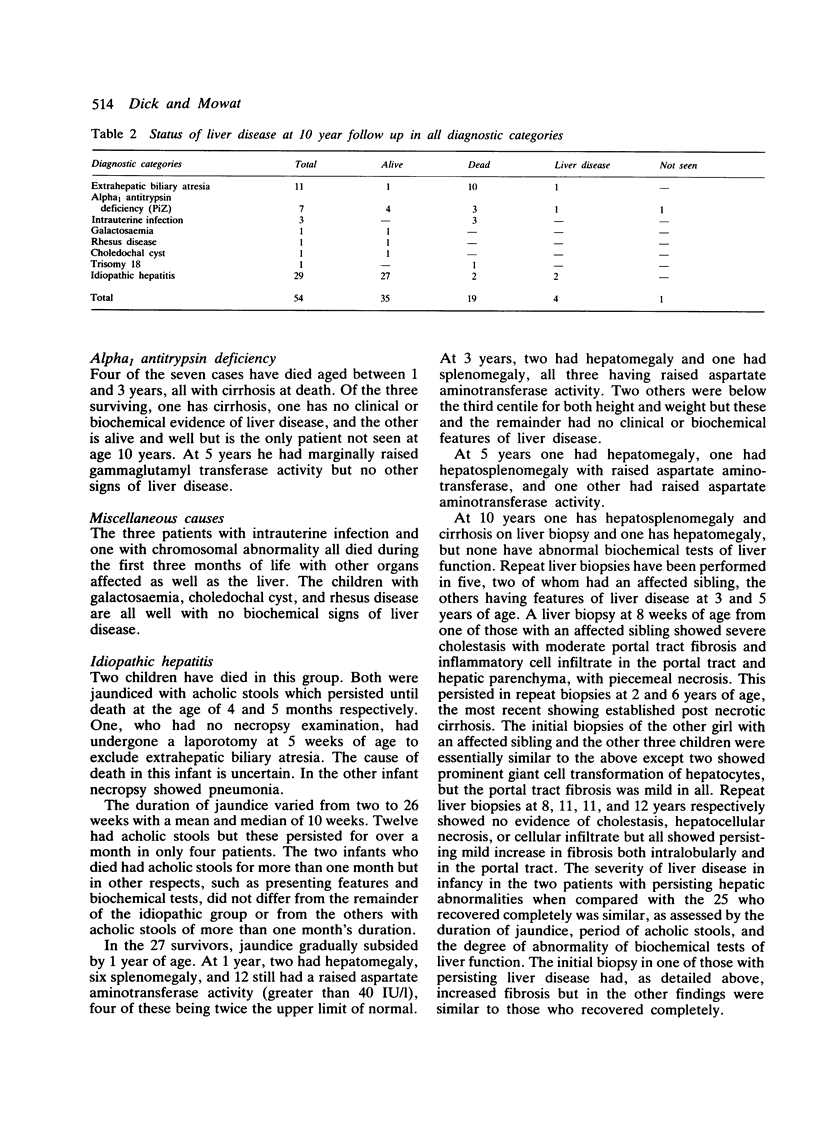
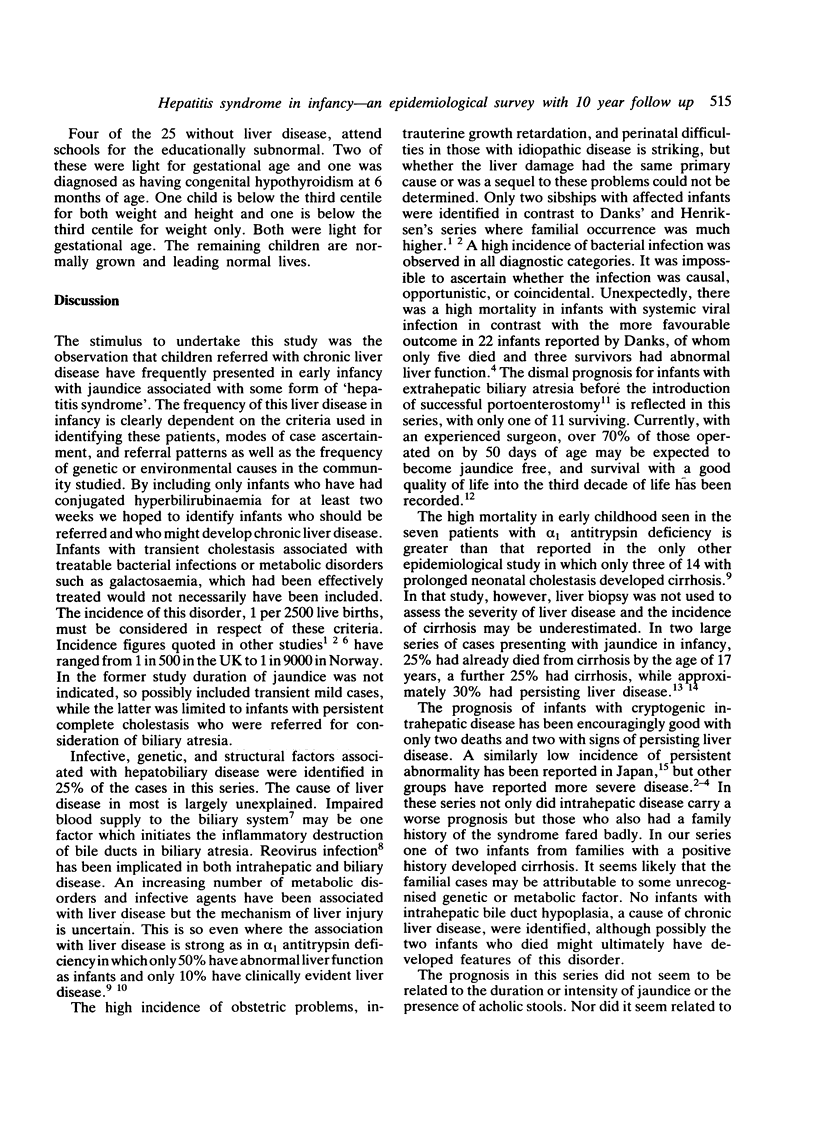
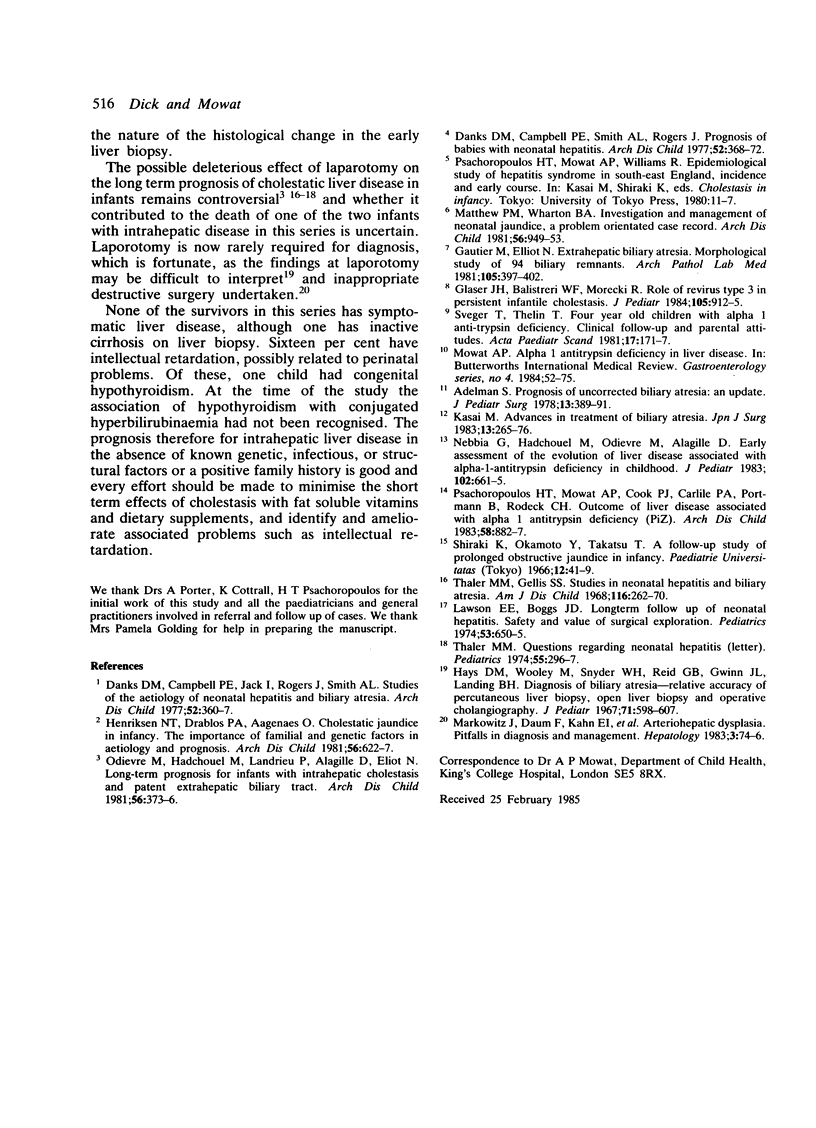
Selected References
These references are in PubMed. This may not be the complete list of references from this article.
- Adelman S. Prognosis of uncorrected biliary atresia: an update. J Pediatr Surg. 1978 Aug;13(4):389–391. doi: 10.1016/s0022-3468(78)80462-x. [DOI] [PubMed] [Google Scholar]
- Danks D. M., Campbell P. E., Jack I., Rogers J., Smith A. L. Studies of the aetiology of neonatal hepatitis and biliary atresia. Arch Dis Child. 1977 May;52(5):360–367. doi: 10.1136/adc.52.5.360. [DOI] [PMC free article] [PubMed] [Google Scholar]
- Danks D. M., Campbell P. E., Smith A. L., Rogers J. Prognosis of babies with neonatal hepatitis. Arch Dis Child. 1977 May;52(5):368–372. doi: 10.1136/adc.52.5.368. [DOI] [PMC free article] [PubMed] [Google Scholar]
- Gautier M., Eliot N. Extrahepatic biliary atresia. Morphological study of 98 biliary remnants. Arch Pathol Lab Med. 1981 Aug;105(8):397–402. [PubMed] [Google Scholar]
- Glaser J. H., Balistreri W. F., Morecki R. Role of reovirus type 3 in persistent infantile cholestasis. J Pediatr. 1984 Dec;105(6):912–915. doi: 10.1016/s0022-3476(84)80076-1. [DOI] [PubMed] [Google Scholar]
- Hays D. M., Woolley M. M., Snyder W. H., Jr, Reed GB GWINN J. L., Landing B. H. Diagnosis of biliary atresia: relative accuracy of percutaneous liver biopsy, open liver biopsy, and operative cholangiography. J Pediatr. 1967 Oct;71(4):598–607. doi: 10.1016/s0022-3476(67)80118-5. [DOI] [PubMed] [Google Scholar]
- Henriksen N. T., Drabløs P. A., Aagenaes O. Cholestatic jaundice in infancy. The importance of familial and genetic factors in aetiology and prognosis. Arch Dis Child. 1981 Aug;56(8):622–627. doi: 10.1136/adc.56.8.622. [DOI] [PMC free article] [PubMed] [Google Scholar]
- Kasai M. Advances in treatment of biliary atresia. Jpn J Surg. 1983 Jul;13(4):265–276. doi: 10.1007/BF02469507. [DOI] [PubMed] [Google Scholar]
- Lawson E. E., Boggs J. D. Long-term follow-up of neonatal hepatitis: safety and value of surgical exploration. Pediatrics. 1974 May;53(5):650–655. [PubMed] [Google Scholar]
- Markowitz J., Daum F., Kahn E. I., Schneider K. M., So H. B., Altman R. P., Aiges H. W., Alperstein G., Silverberg M. Arteriohepatic dysplasia. I. Pitfalls in diagnosis and management. Hepatology. 1983 Jan-Feb;3(1):74–76. doi: 10.1002/hep.1840030112. [DOI] [PubMed] [Google Scholar]
- Mathew P. M., Wharton B. A. Investigation and management of neonatal jaundice: a problem-orientated case record. Arch Dis Child. 1981 Dec;56(12):949–953. doi: 10.1136/adc.56.12.949. [DOI] [PMC free article] [PubMed] [Google Scholar]
- Nebbia G., Hadchouel M., Odievre M., Alagille D. Early assessment of evolution of liver disease associated with alpha 1-antitrypsin deficiency in childhood. J Pediatr. 1983 May;102(5):661–665. doi: 10.1016/s0022-3476(83)80230-3. [DOI] [PubMed] [Google Scholar]
- Odièvre M., Hadchouel M., Landrieu P., Alagille D., Eliot N. Long-term prognosis for infants with intrahepatic cholestasis and patent extrahepatic biliary tract. Arch Dis Child. 1981 May;56(5):373–376. doi: 10.1136/adc.56.5.373. [DOI] [PMC free article] [PubMed] [Google Scholar]
- Psacharopoulos H. T., Mowat A. P., Cook P. J., Carlile P. A., Portmann B., Rodeck C. H. Outcome of liver disease associated with alpha 1 antitrypsin deficiency (PiZ). Implications for genetic counselling and antenatal diagnosis. Arch Dis Child. 1983 Nov;58(11):882–887. doi: 10.1136/adc.58.11.882. [DOI] [PMC free article] [PubMed] [Google Scholar]
- Sveger T., Thelin T. Four-year-old children with alpha 1-antitrypsin deficiency. Clinical follow-up and parental attitudes towards neonatal screening. Acta Paediatr Scand. 1981 Mar;70(2):171–177. doi: 10.1111/j.1651-2227.1981.tb05537.x. [DOI] [PubMed] [Google Scholar]
- Thaler M. M., Gellis S. S. Studies in neonatal hepatitis and biliary atresia. II. The effect of diagnostic laparotomy on long-term prognosis of neonatal hepatitis. Am J Dis Child. 1968 Sep;116(3):262–270. doi: 10.1001/archpedi.1968.02100020264006. [DOI] [PubMed] [Google Scholar]
- Thaler M. M. Letter: Questions regarding neonatal hepatitis. Pediatrics. 1975 Feb;55(2):296–297. [PubMed] [Google Scholar]


